
Ceratomia amyntor, the elm sphinx or four-horned sphinx, is a North American moth in the family Sphingidae. The species was first described by Carl Geyer in 1835. It has a wingspan of 3+1⁄4-4+1⁄2 inches. As the name suggests, the larvae (caterpillars) feed on elm trees (Ulmus), but they can also be found feeding on birch (Betula), basswood (Tilia), and cherry (Prunus). When the caterpillars are ready, they crawl to the bottom of the host tree, where they crawl underneath the soil and pupate and may overwinter underground if late enough into the year. Vegetable growers should be aware of this larvae due to its insatiable appetite. One of these larvae are capable in devouring huge amounts of plant's foliage and even succulent stems.

Ceratomia hageni, the Osage orange sphinx or Hagen's sphinx, is a hawk moth in the family Sphingidae. The species was first described by Augustus Radcliffe Grote in 1874.
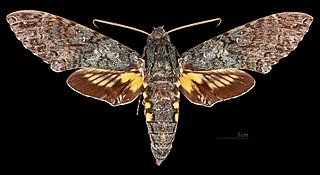
Amphonyx duponchel, or Duponchel's sphinx, is a moth of the family Sphingidae. The species was first described by Felipe Poey in 1832.

Manduca muscosa, the muscosa sphinx, is a moth of the family Sphingidae.

Paratrea is a monotypic moth genus in the family Sphingidae erected by Augustus Radcliffe Grote in 1903. Its single species, Paratrea plebeja, the plebeian sphinx moth, was first described by Johan Christian Fabricius in 1777. It is found in the eastern part of the United States as far west as Nebraska, Kansas, Oklahoma and eastern Texas.

Lapara bombycoides, the northern pine sphinx is a moth of the family Sphingidae. The species was first described by Francis Walker in 1856.
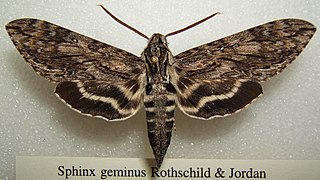
Lintneria geminus, the gemmed sphinx, is a moth of the family Sphingidae. The species was first described by Walter Rothschild and Karl Jordan in 1903. It is found from Mexico to Honduras and Nicaragua with an occasional stray into Texas.
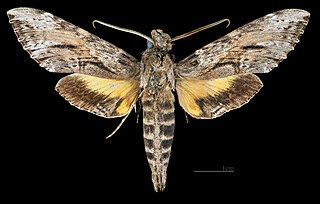
Isognathus rimosa, the rimosus sphinx, is a moth of the family Sphingidae. The species was first described by Augustus Radcliffe Grote in 1865.
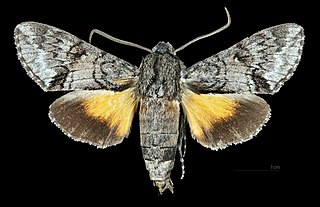
Cautethia grotei, or Grote's sphinx, is a moth of the family Sphingidae. It was described by Henry Edwards in 1882.

Eumorpha intermedia, the intermediate sphinx, is a moth of the family Sphingidae. The species was first described by Benjamin Preston Clark in 1917. It lives in the US states of North Carolina, Florida, Mississippi, Louisiana, and southern Texas.

Eumorpha satellitia, the satellite sphinx, is a moth of the family Sphingidae. The family was first described by Carl Linnaeus in 1771. It lives from Brazil and northern Argentina north through Central America, Mexico, and the West Indies to south Texas and southern Arizona.

Hemaris gracilis, the slender clearwing or graceful clearwing, is a moth of the family Sphingidae. The species was first described by Augustus Radcliffe Grote and Coleman Townsend Robinson in 1865.

Xylophanes robinsonii is a moth of the family Sphingidae first described by Augustus Radcliffe Grote in 1865. It is known from Cuba.

Proserpinus vega, the vega sphinx moth, is a moth of the family Sphingidae. The species was first described by Harrison Gray Dyar Jr. in 1903. It is found from southern Arizona, New Mexico and Texas south into Mexico.

Euproserpinus phaeton, the Phaeton primrose sphinx moth, is a moth of the family Sphingidae. the species was first described by Augustus Radcliffe Grote and Herbert C. Robinson in 1865. It is found in North America from California south to Baja California Sur and further into Mexico. It has also been reported in south-western Arizona.

Erinnyis pallida, the pallid sphinx, is a moth of the family Sphingidae. The species was first described by Augustus Radcliffe Grote in 1865. It is known to be common in Cuba.

Madoryx bubastus is a moth of the family Sphingidae. It is found in Central America and South America, including French Guiana and Venezuela south to at least Bolivia and Argentina. It is also present in Mexico.
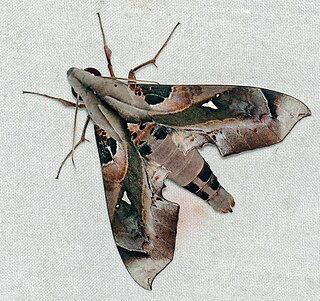
Madoryx plutonius is a moth of the family Sphingidae.

Adhemarius sexoculata is a species of moth in the family Sphingidae. It was described by Augustus Radcliffe Grote in 1865,
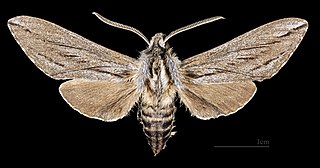
Sphinx sequoiae, the sequoia sphinx, is a moth of the family Sphingidae. It is found in the United States from Oregon south through California, Nevada, and south-eastern Utah to Arizona and further south into Mexico's northern Baja California.





















